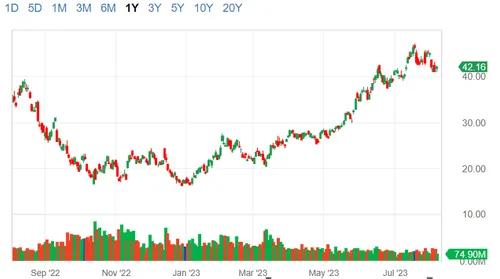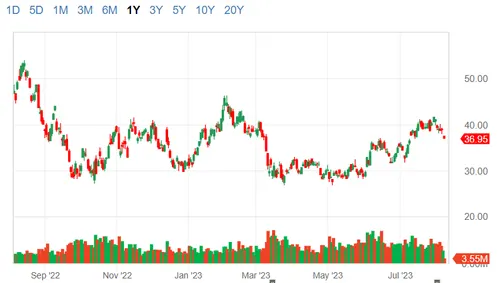Our partner, XM, lets you access a free demo account to apply your knowledge.
No hidden costs, no tricks.

Exchange-traded funds, or ETFs, are popular methods of investing in the stock market. They are composed of a basket of assets and provide some much-needed diversification to a portfolio.
However, ETFs can vary greatly in their composition and volatility, which is why it is important to carefully consider multiple options before putting your capital at risk.
Some ETFs come with leverage and allow traders to get considerably higher returns than they would by simply buying shares in one of the hundreds of ETFs available on the stock market.
While leveraged ETFs may be more promising and could deliver greater returns, they are also considerably more risky than standard actively managed ETFs and index funds.
Regardless, if you are a trader with a higher-than-average risk tolerance, leveraged ETFs could come in handy during bull runs in specific sectors and markets.
Leveraged ETFs are a subset of exchange-traded funds that aim to deliver amplified returns by using various financial instruments on a benchmark index. They use derivatives and debt to magnify the daily performance of the underlying index.
Leveraged ETFs are designed for short-term trading and are generally not suited for long-term investment.
Here’s how a leveraged ETF generally works:
The best-leveraged ETFs are characterized by a high trading volume, which gives traders much-needed liquidity, a minimum of 2X leverage for higher returns, and a reliable underlying index that is relatively easy to track and gather data on,
ProShares and Direxon are two of the most popular ETF issuers, with funds tracking a wide number of important benchmark indexes across all major sectors of the economy.
The ProShares UltraPro QQQ is an ETF that tracks the performance of the Nasdaq-100, which is one of the most important and widely followed indexes of the U.S. stock market.
TQQQ’s 3X leverage aims to deliver three times the returns of the underlying index.
The fund is designed for traders with a short-term bullish outlook on large-cap Nasdaq stocks, such as Apple, Microsoft, Alphabet, etc.
The fund invests exclusively in derivative contracts and does not hold any equity in its portfolio. The average 3-month trading volume for TQQQ shares is 137.4 million.
TQQQ has an expense ratio of 0.86% and was launched on February 9, 2010.

The ProShares UltraPro QQQ ETF has returned more than 20% over the past 12 months of trading.
The ProShares UltraPro Short QQQ is another ETF that tracks the Nasdaq-100 index and seeks to deliver inverse returns. When the Nasdaq-100 goes up, SQQQ goes down by three times as much, as the ETF has a 3X short leverage.
SQQQ is designed for traders with a short-term bearish sentiment on large-cap Nasdaq stocks.
The expense ratio of SQQQ is 0.95%, with an average 3-month trading volume of 130.1 million shares.
SQQQ was also launched on February 9, 2010.

SQQQ has lost over 50% of its value over the past 12 months, while the Nasdaq-100 has gained 16% over the same period.
The ProShares UltraPro S&P 500 ETF, or UPRO, is a more stable ETF that tracks the performance of the main stock market benchmark in the United States - the S&P 500.
The fund was launched on June 25, 2009, with a 3X leverage and an expense ratio of 0.91%.
The average 3-month trading volume for UPRO is 9.4 million shares.
The fund was developed for traders that have a bullish stance on the S&P 500. However, UPRO is also viable as a long-term investment, as the fund tracks one of the most stable and liquid indexes in the world.
UPRO has underperformed the S&P 500 over the past 12 months. The fund has returned 5.85%, while the S&P 500 has returned 8.15% over the same period.

This is due to the 3X leverage of UPRO, which means that the downturns of the fund are also amplified threefold.
The Direxion Daily Small Cap Bull 3X ETF, or TNA, is a highly volatile leveraged ETF with a focus on small-cap stocks primarily listed on the NYSE.
The fund, which was launched on November 5, 2008, has an expense ratio of 1.09%.
Due to the focus on small-cap stocks and 3X leverage, TNA can be a highly volatile ETF, which makes it attractive for short-term traders who wish to profit off of short-term trend reversals on the equities market.
The fund has an average 3-month trading volume of 13.2 million shares.

TNA has lost roughly 22% over the past year. However, with many ups and downs during that period, the fund has shown to be very attractive for short-term traders.
Direxion Daily Tech Bull 3X ETF is another short-term bullish leveraged technology ETF by Direxion, which tracks the Technology Select Sector ETF.
The fund’s 3X leverage makes it ideal for short-term tech bulls and makes TECL a highly volatile ETF.
TECL, which was launched on December 17, 2008, has an expense ratio of 0.97% and a 3-month daily average trading volume of 2.5 million shares.

TECL has returned over 18.5% over the past 12 months, which makes it a market-beating ETF for that period.
The Direxion Daily S&P 500 Bull 3X also tracks the S&P 500 and aims to deliver 3X returns. The fund is highly volatile and ideal for short-term bullish traders.
SPXL was launched on November 5, 2008, and has an expense ratio of 1%, with a 3-month average daily trading volume of 12.9 million shares.

SPXL has returned 6% over the past 12 months, which is in line with the returns of the S&P 500 over the same period.
Before risking your hard-earned money, it is crucial to consider the inherent advantages and risks associated with trading leveraged ETFs to avoid any costly uninformed decisions.
Our partner, XM, lets you access a free demo account to apply your knowledge.
No hidden costs, no tricks.
Leveraged ETFs are exchange-traded funds that use financial derivatives to amplify the returns of the underlying index. Leveraged ETFs can have higher expense ratios due to daily rebalancing and are generally more volatile than standard ETFs.
Most leveraged ETFs aim to deliver 2X or 3X returns by using swaps, futures, and options on the underlying index. The higher the leverage, the riskier the ETF becomes.
Leveraged ETFs are generally riskier than standard ETFs because they use derivatives, which amplify the potential gains and losses.